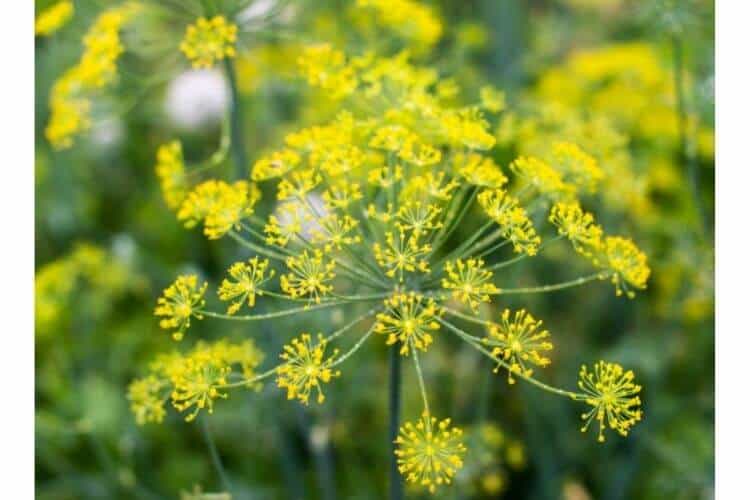I badly needed another herb to grow in the shade in my garden. My trees and other taller plants tend to block a large section of the garden from full sunlight. Dill caught my mind as one of the most interesting options. One question I had was whether or not Dill could grow under those conditions? Is there anything too special about growing Dill under these circumstances? It turns out this is an excellent choice!
Does Dill grow in the shade?
Dill can grow in partial but not full shade. In full shade, dill won’t grow tall or blossom like it would in partial shade. Dill needs at least 3 hours of sunlight a day for proper growth and blossoming. In full sun dill will grow to its maximum height of 2 to 3 feet and fully blossom.
Growth requirements of Dill under the shade
Growing dill under the shade is a unique challenge. Here are some helpful tips for you to get started:
Table of Contents
Sunlight
Dill needs at least partial sun, so make sure it has all access to sunlight by pruning out other plants that may be blocking its way.
Location
Location is important when growing in the shady conditions because full shade might not be conducive for Dill and it can cause death of this herb due to lack of sunlight. Make sure there aren’t any tall or bushy plants around so they won’t block out most sun from reaching your plant’s location as well!
Remember, the location you select should be less affected by frost. This rule is applied primarily during spring when frost is expected. So always make sure you check on your last frost dates and create a perfect timing to avoid it.
Soil preparation
To grow Dill under a shade, the very first thing you will need is the best soil. Soil rich in organic matter and also properly drained is the best habitat for this herb. This means that you should add compost manure that is well-aged. This manure is added to the seedbed before the planting date. Technically, Dill prefers a soil PH of 5.5 to 6.8.
Dill does not like too much amount of water. Therefore, before you plant and start the watering process, the soil must be dried up thoroughly. Another reason for letting the soil dry for a while is because of the shade.
Under the shade, the soil undergoes less evaporation. This factor might lead to too much moisture below, thus causing wilting. Wilting results in drooping of the leaves, and the plant dies. Also, the soil should not be dried. You will, therefore, need to keep the process balanced.
Culture
Thinning of Dill seedlings should be done in about 15 days. This process is done after you spot them appearing in the soil. After more than 15 days, check out the rows and thin each plant again to ensure you have one dill plant per every 18 to 20 space inches.
The primary purpose of thinning is to ensure that each plant gets adequate space. Thinning also makes it possible for the sunlight to reach each plant. This feature is essential since the plants are growing under a shed. Therefore, the process plays a significant role in utilizing minimal sunlight.
Pests
Despite Dill being resistant to diseases, several pests might tend to make attacks.
These pests may include parsley caterpillars and the tomato hornworms. In any garden that you might come across, these two pests are the most common. If you come across a white, black, and yellow insect with a mixture of spots, that will be a Parsley caterpillar. On the other hand, Tomato hornworms appear to be green in color.
Do not worry. Controlling these pests is easy. The easiest way is to remove them physically by handpicking them.
Note: Always remember to use gloves while physically removing these pests. They are harmless, but sometimes they tend to bite. This behavior applies when it comes to Parsley warms.
Due to minimal light under the shed, some Dill plants may grow taller. This feature explains that you will need to create stakes to hold up the plants straight whenever you take note of that scenario.
Facts about Dill
- The botanical name of Dill is Anethum graveolens.
- Despite it being grown as an annual herb, in a real sense, it is biennial.
- Dill is a bushy plant whose foliage is feathery
- The best growing time for Dill is spring throughout fall.
- Dill survives in both cold and heat but does well in the heat.
- It grows in zones of 2 to 11
- The small greenish-yellow flowers of Dill bloom in clusters of about 6 inches
- The seeds of Dill ripen in early autumn.
- The flowers of Dill also start to bloom in the mid of summer throughout autumn.
- Dill seeds are oval, flat brown, but light.
When to plant Dill
Dill is a herb that preferably grows In warm climatic conditions. It can be negatively affected by even the smallest amount of frost. Therefore, this fact explains that you need to plant your seedlings around January or February.
Planting the herb during this season saves it from too much moisture. This moisture causes the leaves to turn yellow, wilt up, and the plant gets damaged.
How to plant Dill under the shade
Dills can be planted in the usual common way in beds on the ground. But there are several other alternatives, especially if you don’t have a ground garden. The alternatives include pots, containers, and even boxes.
When you follow the right procedure, Dill planting can be unbelievably uncomplicated. The process is as follows bellow.
Growing Dill from seeds
Growing this herb from seed is the best way possible. It is better than transplanting since it has long taproots that might affect other garden plants like carrots.
Therefore, to grow Dill from seeds, you will need to:
- Plan the sowing of your seeds 2 to 3 weeks after the last spring you experienced.
- Make a proper preparation of the soil. This process is done by wetting and mixing the earth from the ground with compost. The wetting should be light.
- Gently press the soil into the soil surface. After this procedure, you should cover the seeds lightly with soil. You can also leave them open in the ground. This procedure will increase the germination process since Dill requires light for growth. When you choose to cover the earth, always ensure that the soil cover is only 1/8 of an inch.
- Make sure that in every 4 to 6 inches, you plant a group of 3 seeds. Twelve inches should also always be maintained in the middle of each row.
- The seedbed or place where you planted should receive gentle watering each day until the seedlings emerge out.
Note: Normal germination takes 10 to 14 or 15 days. This statistical fact is not a guarantee since it might take longer than other times.
Don’t forget to start the thinning process as soon as seedlings are a few inches tall. Mostly do this to the weaker seedlings. This procedure will help significantly in spacing. You should always make sure that the spacing is maintained at 4 inches apart between each seedling.
This spacing facilitates the air circulation process.
Transplanting
If you choose to grow your Dill by transplanting, here are the facts that you should keep into consideration.
- Put the plant in its container or the spot you’ve chosen under the shade. This procedure will assist the plant in adapting to the new environment and its conditions.
- After selecting the correct spot for planting, place a few inches of compost manure into the ground.
- Using a shovel, dig out a hole for the plant. For the roots to hold up well in the soil, make sure that the gap is large and spacious enough.
- The plant’s roots should be placed together with the soil gently into the ground or the spot of growing.
- Ensure you water the Dill plant regularly till it can depend on its own in the new location.
How to encourage re-flowering in Dill
Dill is usually treated as an annual plant. Therefore, after a year, you can choose to re-flower it by transplanting. It would help if you prevented its taproot from getting damaged by replanting it directly in the garden.
You have to do this transplant past the frost season. Remember to ensure the supply of compost manure.
Harvesting of Dill
In standard growing conditions, Dill gets ready after 90 days. But even before flowering begins, the leaves can be harvested earlier. This harvest is done because most flavors are contained here.
Dill seeds out after once the flowers form. You will need to cut the seed head for 2 to 3 weeks. Allow the cutting to dry in a plastic bag.
You will know they are ready once the seeds fall off.
Frequently asked questions.
Will Dill grow in the shade?
Yes. All you have to do is find a way to allow minimal sunlight through. Also, maintain other conditions like soil PH and aeration.
What time of the year do I grow, Dill?
Do the planting the time of the year when the temperature is relatively warm.
Conclusion
I grew Dill under the shade, and it thrived. To also do the same, all you need to do is follow the procedures we discussed in this article. Make a timing of around January and February. Do not forget that warm temperature is the secret for Dill.

